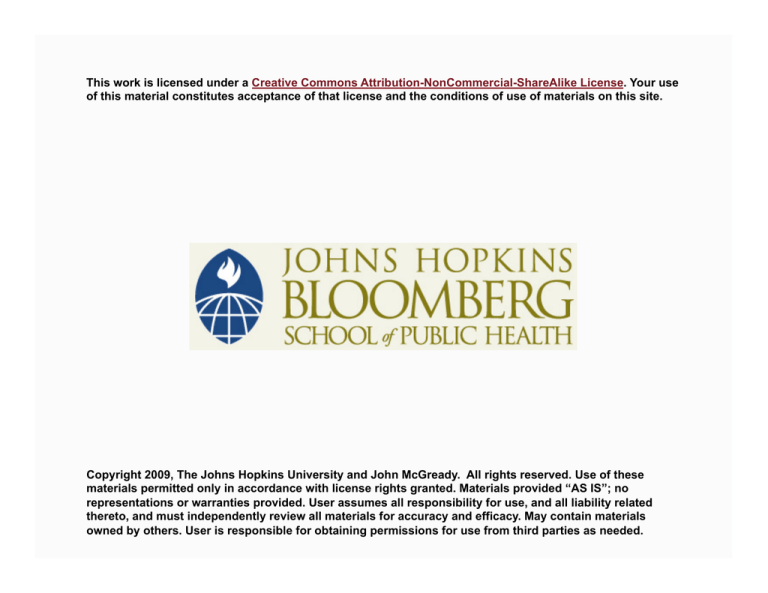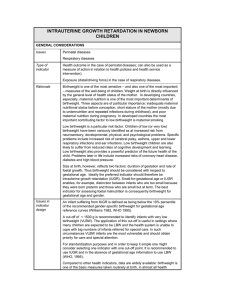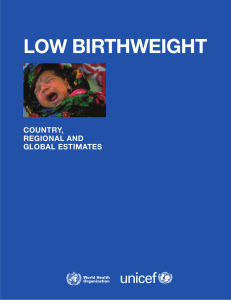
This work is licensed under a Creative Commons Attribution-NonCommercial-ShareAlike License. Your use
of this material constitutes acceptance of that license and the conditions of use of materials on this site.
Copyright 2009, The Johns Hopkins University and John McGready. All rights reserved. Use of these
materials permitted only in accordance with license rights granted. Materials provided “AS IS”; no
representations or warranties provided. User assumes all responsibility for use, and all liability related
thereto, and must independently review all materials for accuracy and efficacy. May contain materials
owned by others. User is responsible for obtaining permissions for use from third parties as needed.
Lecture 1c: Practice Problem Solutions
John McGready
Johns Hopkins University
Practice Problems
1. The following data is the annual income (in $1,000s of U.S. dollars)
taken from nine students in the Hopkins internet-based MPH
program:
37 102 34 12 111 56 72 17 33
3
Practice Problems
a) Calculate the sample mean income
- Where n = 9 and x1 through x9 represent the nine observed
values of income:
-
In this sample:
(the sample mean income is $52,700)
4
Practice Problems
b) Calculate the sample median income
- To calculate the sample median, we must first order our data
from the lowest value to the highest value
12 17 33 34 37 56 72 102 111
-
Since there are nine observations, the median is the value
directly in the center: the 5th ranked observation
12 17 33 34 37 56 72 102 111
-
The sample median income is $37,000
5
Practice Problems
c) Calculate the sample standard deviation of these incomes.
- In this sample of nine observations, the formula for the SD is:
-
Now:
6
Practice Problems
c) So:
-
The sample standard deviation is $35,600: on average, each of
the nine observed incomes falls about $35,600 away from the
sample mean (above or below)
7
Practice Problems
d) What population could this sample represent?
- It could be representative of the population of all Johns Hopkins
Internet-based MPH students
8
Practice Problems
e) Which would change by a larger amount—the mean or median—if
the 34 were replaced by 17, and the 12 replaced by a 31?
- Notice that both changes do nothing to change the position of
the median; therefore, the only statistic of the two that would
change is the mean (the sample standard deviation would also
change)
9
Practice Problems
2. The following data shows birthweights (oz) from seven consecutive
deliveries at the Johns Hopkins Hospital
121 138 32 100 58 64 146
10
Practice Problems
a) Calculate the sample mean birthweight
b) Calculate the sample median birthweight
c) Calculate the sample standard deviation of these birthweight
- I’m using Stata to do the first three questions!
- Data in Stata:
11
Practice Problems
a) Calculate the sample mean birthweight
b) Calculate the sample median birthweight
c) Calculate the sample standard deviation of these birthweight
- summarize command with detail option
12
Practice Problems
d) What population could this sample represent?
- This could possibly be representative of all births in a fixed time
period (one month, one year?) at Johns Hopkins hospital, and
possibly other U.S. urban teaching hospital
- However, we may want to ask a few questions of the researcher
who collected this data before making this conclusion
13
Practice Problems
e) Suppose this is a representative sample of births in a given year at
Johns Hopkins
- Suppose, instead of a sample of seven values, we have a sample
of 100 birthweights
- How should the mean, median and standard deviation of this
sample compare to the same statistics for the sample of seven
birthweights?
-
-
-
Answer: The mean, median and SD from the sample of 100 will
likely not equal their counterparts from the sample of seven
However, all should be “similar” in value
There is no way to ascertain how each of these will differ across
the samples (i.e., which sample would have the larger sample
mean, etc.)
14








